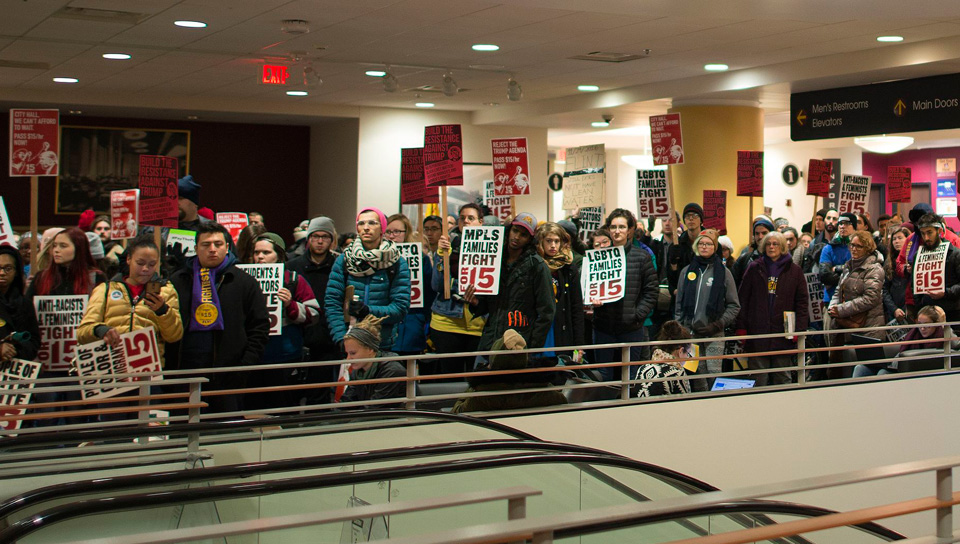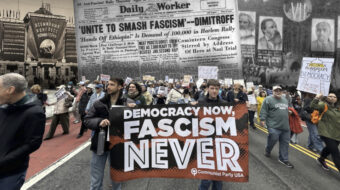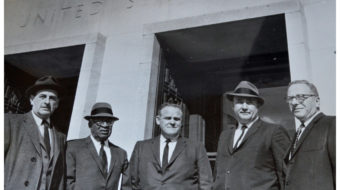
On July 24, 2009, the federal U.S. minimum wage rose to $7.25 per hour, up from $6.55.
In the 2010 midterm elections, many voters typically stayed home, and Republicans took control of the House of Representatives. There has not been a wage increase in eight years.
In real terms, that is, in purchasing power, the federal minimum wage peaked near $10.00 per hour in 1968, using 2014 inflation-adjusted dollars. In other words, the American working class has been in a steady economic decline for the last almost 50 years, despite a near doubling of productivity.
There are presently 29 states with a minimum wage higher than the federal minimum, as well as several cities. In some places the minimum wage has been increased to as much as $15.00 an hour, but that rate kicks in gradually over the course of years.
San Francisco is expected to become the first U.S. city to reach a minimum wage of $15.00 per hour on July 1, 2018. New York City’s minimum wage will be $15.00 per hour by the end of 2018. Minimum wage in Los Angeles and Washington, D.C., will be $15.00 per hour in 2020.
There are still 21 states left which are governed by the federal minimum wage.
In an economy increasingly characterized by the service sector, a raise in the minimum wage affects the lowest-paid workers. In our racialized society that translates to higher wages for people of color. Militant demonstrations and movements have propelled this issue to the forefront of public policy in recent years. Activists have argued that there is no place in the country, especially not in the cities, where the existing minimum wage can support a human being in all the necessities. The dominant call, led by fast-food workers, has been for $15 an hour.
The largest private employer in the United States, Walmart, has a sweet deal going for itself. It is possibly the largest recipient of corporate welfare, although this fact is hidden in the absence of a federal living wage law. Low-paid Walmart workers, even if full-time, do not earn enough to support themselves and their families. With the wages they receive, they cannot “reproduce” themselves, that is, by living adequately well enough to raise the next generation of workers.
Many Walmart workers receive food stamps, health care and other benefits directly from the federal, state or local governments. In some stores last year Walmart was shamed for having sponsored Thanksgiving food drives for its own employees! Therefore, the entire American society is in effect providing this “welfare” to Walmart to make up for its deficient pay to its employees. Family members who own and control Walmart are among the richest dozen individuals in the world thanks to U.S. tax dollars.
In some jurisdictions, the minimum wage is linked to the Consumer Price Index, thereby increasing the wage automatically each year.
Former President Bill Clinton advocated raising the minimum wage in 2014: “…it doesn’t just raise wages for the three or four million people who are directly affected by it, it bumps the wage structure everywhere…. If you [raise the minimum wage] in a phased way, it always creates jobs. Why? Because people who make the minimum wage or near it are struggling to get by, they spend every penny they make, they turn it over in the economy, they create jobs, they create opportunity, and they take better care of their children. It’s just the right thing to do, but it’s also very good economics.”
Under Trump-era conditions, however, workers may see any raises they receive get eaten away in a myriad of ways: higher rents, higher prices for food, fewer scholarships for students, much higher health care costs and greater sickness, abolition of consumer protections, to cite just a few examples. Employers may also cut back staff, robotize more jobs, and make even more positions less than full-time and thereby ineligible for benefits. It came out in the screenings of some of Trump’s choices for cabinet positions that they did not even believe in the concept of a minimum wage, much less support raising it.
Republicans in the Missouri statehouse, backed by the governor, recently rescinded a pay raise, rolling back a $10 wage to $7.70, effective this coming August 28th.
While in theory, an increase in the minimum wage is a form of redistribution from the capitalist class to the working class, thereby reducing income inequality, an avalanche of new legislation along GOP lines may just set the bar of exploitation a little higher, with no perceptible improvement. This explains why Marxist and other progressive thinkers have often argued against merely “economist” demands that do not also contribute to restructuring the economy as such and/or to preparing the consciousness of the working class for higher levels of struggle.
A little history
“No business which depends for existence on paying less than living wages to its workers has any right to continue in this country,” said President Franklin Delano Roosevelt in 1933, the year he assumed the presidency.
That year, as the country groaned under the worst ravages of the Great Depression, the Roosevelt administration made the first attempt at establishing a national minimum wage, when a $0.25 per hour standard was set as part of the National Industrial Recovery Act. However, in the 1935 the Supreme Court declared the act unconstitutional, and the minimum wage was abolished. In 1938, the minimum wage was re-established pursuant to the Fair Labor Standards Act, once again at $0.25 per hour.
The 1938 minimum wage law only applied to “employees engaged in interstate commerce or in the production of goods for interstate commerce,” but in amendments in 1961(in John F. Kennedy’s administration) and 1966 (in Lyndon B. Johnson’s administration), the federal minimum wage was extended, with slightly different rates, to employees in large retail and service enterprises, local transportation and construction, state and local government employees, as well as other smaller expansions; a grandfather clause in 1990 drew most employees into the purview of federal minimum wage policy, which now set the wage at $3.80.
Although the federal minimum wage is currently $7.25 per hour, some U.S. territories (such as American Samoa) are exempt. Some types of labor are also exempt: employers may pay tipped labor a minimum of $2.13 per hour, as long as the hour wage plus tip income equals at least the minimum wage. Persons under the age of 20 may be paid $4.25 an hour for the first 90 calendar days of employment (sometimes known as a youth, teen, or training wage) unless a higher state minimum exists. Even where minimum wage covers farm workers, abuse continues to haunt them in such classic forms as having to pay for the use of farm implements, exposure to toxic chemicals, having to rent overpriced company housing and buy from company stores, refusal to negotiate union contracts, etc.
In 2014, voters in the Republican-controlled states of Alaska, Arkansas, Nebraska and South Dakota considered ballot initiatives to raise the minimum wage above the national rate of $7.25 per hour, which were successful in all four states. The results provided evidence that raising minimum wage has support across party lines.
The way out cannot lie only in efforts to raise the minimum wage. These movements must be combined with political work—such as electing pro-labor candidates to office on all levels—so that the fundamental abuse of people that is inherent in a capitalism always seeking to maximize profit is permanently controlled, and perhaps eventually abolished.
Adapted from Wikipedia and other sources.










